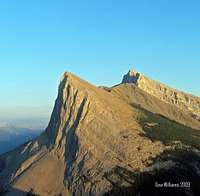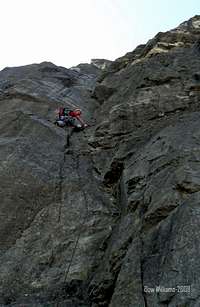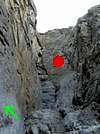-
 8074 Hits
8074 Hits
-
 89.01% Score
89.01% Score
-
 28 Votes
28 Votes
|
|
Route |
|---|---|
|
|
51.08056°N / 115.42222°W |
|
|
Trad Climbing |
|
|
Summer |
|
|
Most of a day |
|
|
5.9 (YDS) |
|
|
13 |
|
|
Overview/Approach
I have climbed most of the routes on EEOR (Mount Rundle’s east face, overlooking Canmore) including Girls Lie, 5.11, which graces the front cover of the Bow Valley Rock guide. Chris Perry is the author of that book. He also help put in what I consider my second favorite route on EEOR, after Girls Lie, named Dropout at 5.9. Dropout has been established for a long time by EEOR standards, 1982, but few have actually climbed the route as it is rarely in condition. One of the reasons I like it so much is that rock is solid by EEOR standards. The reason the rock is solid is because this route serves as a constant drainage of snow from the backside (northeast) of EEOR’s summit. The slow moving waterfall keeps the rock clean, albeit a bit greasy. The reason the route is rarely in condition to climb is because snow lingers in the summit bowl that drains on this route well into July most years. I have discovered that the routes to the right side of EEOR (take most calorie burn to get to) are the choice routes of the wall, without question.
It took me two attempts to complete Dropout. The first go was in early July with one of my regular Canmore partners. We both live with clear views of EEOR from our homes. Yet we both pretended that the dark streak which marks the route was just a stain versus running water. Once we got to the base of the route, I still wanted to give it a go even though she was a bit apprehensive as the waterfall was still active. My promise to lead the pitches and endure any pending waterfall crossings was enough to entice her to give it a go. However, once we got into the 9th pitch, I was getting soaked head to toe climbing directly into a waterfall. With a single 70m rope, retreat is quite interesting on this route but can be manipulated without leaving gear.
In late August, I gave Dropout a more reasonable go and found conditions dry. Having been up the first nine pitches twice and now having completed the route, in my opinion Dropout is rather spectacular compared to other 5.9 routes on EEOR or Yamnuska. The first two pitches are born of a fantastic continuous corner at the grade on very good rock by Canadian Rockies standards. Place gear, stem, repeat. I combined these pitches on both outings. There is sort of a mid roof you need to double sling any pro below if you want to avoid rope drag, as this will be a full 60m if combining these two pitches. The final roof on this corner at the top of the 2nd pitch might be the crux move of the climb. It is well protected with a 3” piece up in the roof but requires a traverse out left on a sandy finger ledge with no feet to exit. The 3rd pitch is not very exciting and is on relatively poor rock. The fourth pitch meanders up a fun corner way out right that you must exit back left via good cracks. The fifth and sixth pitches can be easily combined. The seventh pitch involves some more fun climbing at the grade as you climb a large crack to the left of a massive overhang. Rope drag will be an issue, but it is best to be judicious with your protection and combine the 7th and 8th pitches. The 9th pitch is the crux pitch of the climb, a full on sustained chimney with rough uneven sides. It pinches towards the top as the chimney leads into a large bay and this is where I had to start actually climbing into the water fall on my first attempt. This pitch takes large gear and does have a piton or two, but any piton resting in a waterfall and ice the majority of the year would be suspect pro to say the least. The 10th pitch is a continuation of the same, stemming up from the bay to the top of the chimney. The 10th and 11th pitches can be combined. The 12th pitch exits the bowels of the chimney and sets you up for simul-climbing or soloing the remainder of the route to the top of EEOR.
From the Canmore Nordic Center, ascend the Spray Lakes/Smith Dorrien road (gravel) through the switchbacks to the parking area between Goats Creek and the dam right on the reservoir. This is the most efficient parking area for the trad and sport routes on EEOR. Watch for hazardous rock fall on the switchbacks above Canmore. At times this road will be closed due to rock and/or mud slides. From the reservoir parking area, gain a trail slightly to the south (left of a huge boulder) and ascend steep ground northwest via switchbacks. As you get closer to the south end wall, you will hook into a trail that runs along the base of EEOR. Continue north along the trail for quite a distance turning several corners as the trail peters out. Eventually you reach the start of Drop Out which is an obvious corner route that follows the black streak (wet most of the year) up EEOR’s face.
Route Description
1500/-’+, 13 Pitches, 5.9
1st and 2nd Pitches- 60m- 5.9/ These are no doubt the choice pitches of the route. Scramble up to the base of the corner. There is a fixed station here believe it or not. More in place for a retreat than the climb. The first pitch is the most mellow. Running up the corner on great rock, stemming and placing gear at will. You overcome a small roof with a ledge out left. There are some pitons above the ledge for a rap/belay station. Continue up the corner to the next significant roof above (passing another small roof). Save a 2” or 3” for a critical placement in that roof. Make the crux move of the route by traversing out left on slick rock with no feet and a small sand covered (this is normally part of a waterfall) finger ledge. Make one hard blind move, then mantle up and left to a comfortable mixed belay.
3rd Pitch- 45m- 5.6/ This felt like an easy pitch, but both times, my partners had a difficult time leading it. I took over the first time and observed my partner having a difficult go the 2nd time. So it is one of those pitches that you can make more out it than it really is in my opinion. Climb out right on solid and easy rock moving up to a short steep flake. Climb the flake and ground eases up again. You meander back and forth a bit on loose ground to find the fixed belay up and right, but well left of the next corner pitch out right.
4th Pitch- 35m- 5.8/ Move out right until you can start to ascend the obvious loose corner above. The rock gets much better as you continue to ascend. As the corner closes down to fingers, traverse up and left on large horizontal cracks via steep ground. A fixed belay is hidden out on the arête. Use double slings to avoid rope drag.
5th and 6th Pitches- 60m- 5.6/ Move out left from the belay and continue traversing left on a ramp of sorts until you come to an easy corner on the face. Surmount it and get back into the main corner you have been following up the entire wall. Continue via easy climbing until right below the huge overhang. There is an old bolt here that can be backed up with gear.
7th and 8th Pitches- 60m- 5.8/ No matter how judicious you are about your placements, you will no doubt incur some serious rope drag by combining these pitches. However, I divided them up the first time I climbed Drop Out and did not like my gear placement opportunities. It is better to deal with the rope drag and finish up at the base of the chimney which serves as better pro and a more comfortable belay. Take on the huge overhang to the left via a wide crack. It is easier than it looks with plenty of edges and holds on the left wall. Follow the crack to its terminus, trending right out of it. Avoid placing much pro at this point or clipping any of the old pitons if you want to combine these two pitches. Move back left across broken ground up a short, but challenging and hard to protect wall. Then left along a ledge directly below the chimney above and follow a nice .75” crack up another short steep wall to the base of the chimney. Sling a pedestal for pro.
9th Pitch- 40m- 5.9/ This is definitely the crux pitch of the route and where I got turned around on my first attempt when it was still in waterfall form in late July. The uneven chimney starts out wide on bad yellowish rock. As it constricts towards the top, the rock quality improves. You will twist and turn every which way as you make it up this awkward pitch. You will find a few pitons, but they are quite weathered as this pitch is normally a flowing or frozen waterfall. You eventually break out into a large bay below more chimney climbing. Set up a gear belay in here. Save your larger gear as long as you can or move it along with you.
10th Pitch- 45m- 5.8/ Stem up the wide exit of the chimney (5.8) and mantle up into the narrow chamber that opens up to a large bowl surrounded by steep walls. Set up a fixed gear belay in cracks at the base of the wall straight ahead.
11th Pitch- 35m- 5.6/ Bail tat about half way up the wall straight ahead is an indicator of a previous party getting sucked up the wrong wall. It does look enticing and natural to go straight up the wall ahead. Instead, turn around and head up a broken ramp up the left wall. Set up a gear belay at the top.
12 and 13th Pitches- 120+ 5th/ The last pitches are really just a long 5th class scramble of sorts. It is longer than 120m, so either plan to simul-climb this section or solo it. It is longer to the top of EEOR than you would think from where you finished the 11th pitch.
























